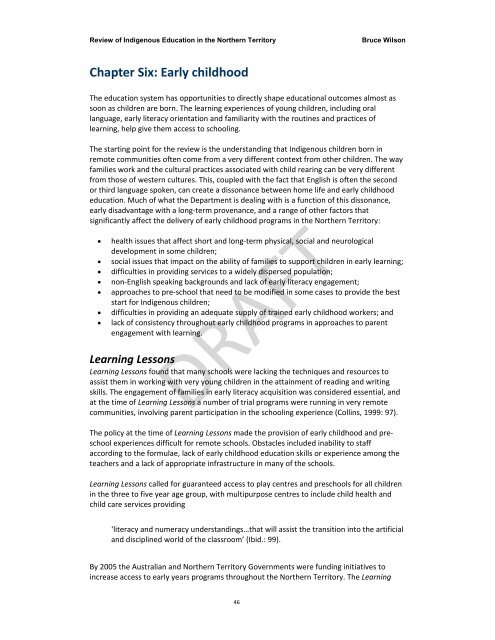Indigenous-Education-Review_DRAFT
Indigenous-Education-Review_DRAFT
Indigenous-Education-Review_DRAFT
You also want an ePaper? Increase the reach of your titles
YUMPU automatically turns print PDFs into web optimized ePapers that Google loves.
<strong>Review</strong> of <strong>Indigenous</strong> <strong>Education</strong> in the Northern Territory<br />
Bruce Wilson<br />
Chapter Six: Early childhood<br />
The education system has opportunities to directly shape educational outcomes almost as<br />
soon as children are born. The learning experiences of young children, including oral<br />
language, early literacy orientation and familiarity with the routines and practices of<br />
learning, help give them access to schooling.<br />
The starting point for the review is the understanding that <strong>Indigenous</strong> children born in<br />
remote communities often come from a very different context from other children. The way<br />
families work and the cultural practices associated with child rearing can be very different<br />
from those of western cultures. This, coupled with the fact that English is often the second<br />
or third language spoken, can create a dissonance between home life and early childhood<br />
education. Much of what the Department is dealing with is a function of this dissonance,<br />
early disadvantage with a long‐term provenance, and a range of other factors that<br />
significantly affect the delivery of early childhood programs in the Northern Territory:<br />
<br />
<br />
<br />
<br />
<br />
<br />
<br />
health issues that affect short and long‐term physical, social and neurological<br />
development in some children;<br />
social issues that impact on the ability of families to support children in early learning;<br />
difficulties in providing services to a widely dispersed population;<br />
non‐English speaking backgrounds and lack of early literacy engagement;<br />
approaches to pre‐school that need to be modified in some cases to provide the best<br />
start for <strong>Indigenous</strong> children;<br />
difficulties in providing an adequate supply of trained early childhood workers; and<br />
lack of consistency throughout early childhood programs in approaches to parent<br />
engagement with learning.<br />
Learning Lessons<br />
Learning Lessons found that many schools were lacking the techniques and resources to<br />
assist them in working with very young children in the attainment of reading and writing<br />
skills. The engagement of families in early literacy acquisition was considered essential, and<br />
at the time of Learning Lessons a number of trial programs were running in very remote<br />
<strong>DRAFT</strong><br />
communities, involving parent participation in the schooling experience (Collins, 1999: 97).<br />
The policy at the time of Learning Lessons made the provision of early childhood and preschool<br />
experiences difficult for remote schools. Obstacles included inability to staff<br />
according to the formulae, lack of early childhood education skills or experience among the<br />
teachers and a lack of appropriate infrastructure in many of the schools.<br />
Learning Lessons called for guaranteed access to play centres and preschools for all children<br />
in the three to five year age group, with multipurpose centres to include child health and<br />
child care services providing<br />
‘literacy and numeracy understandings…that will assist the transition into the artificial<br />
and disciplined world of the classroom’ (Ibid.: 99).<br />
By 2005 the Australian and Northern Territory Governments were funding initiatives to<br />
increase access to early years programs throughout the Northern Territory. The Learning<br />
46


